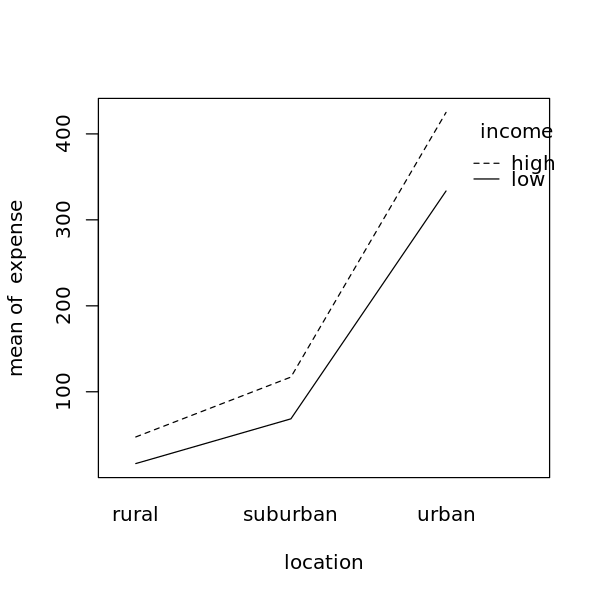4. Hypothesis Testing
[1]:
set.seed(37)
4.1. Student’s t-test
The Student's t-test compares the means of two samples to see if they are different. Here is a two-sided Student’s t-test.
[2]:
x <- rnorm(1000, mean=0, sd=1)
y <- rnorm(1000, mean=1, sd=1)
r <- t.test(x, y, alternative='two.sided')
print(r)
Welch Two Sample t-test
data: x and y
t = -23.159, df = 1998, p-value < 2.2e-16
alternative hypothesis: true difference in means is not equal to 0
95 percent confidence interval:
-1.1425178 -0.9641235
sample estimates:
mean of x mean of y
-0.01839959 1.03492108
Here is a directional Student’s t-test to see if the mean of x is greater than the mean of y.
[3]:
x <- rnorm(1000, mean=0, sd=1)
y <- rnorm(1000, mean=1, sd=1)
r <- t.test(x, y, alternative='greater')
print(r)
Welch Two Sample t-test
data: x and y
t = -22.576, df = 1991.2, p-value = 1
alternative hypothesis: true difference in means is greater than 0
95 percent confidence interval:
-1.118479 Inf
sample estimates:
mean of x mean of y
0.01325957 1.05574987
Here is a directional Student’s t-test to see if the mean of x is less than the mean of y.
[4]:
x <- rnorm(1000, mean=0, sd=1)
y <- rnorm(1000, mean=1, sd=1)
r <- t.test(x, y, alternative='less')
print(r)
Welch Two Sample t-test
data: x and y
t = -22.097, df = 1996.7, p-value < 2.2e-16
alternative hypothesis: true difference in means is less than 0
95 percent confidence interval:
-Inf -0.9224035
sample estimates:
mean of x mean of y
0.01069279 1.00731729
We may also perform a one-sample Student’s t-test.
[5]:
x <- rnorm(1000, mean=0, sd=1)
r <- t.test(x, mu=5)
print(r)
One Sample t-test
data: x
t = -159.87, df = 999, p-value < 2.2e-16
alternative hypothesis: true mean is not equal to 5
95 percent confidence interval:
-0.13452024 -0.01000024
sample estimates:
mean of x
-0.07226024
If your data is in long format, you may use a formula to perform a Student’s t-test.
[6]:
data <- data.frame(
score = c(90, 89, 70, 99, 100, 77, 80, 67, 70),
gender = c(rep('girl', 5), rep('boy', 4))
)
r <- t.test(score ~ gender, data=data)
print(r)
Welch Two Sample t-test
data: score by gender
t = -2.6069, df = 6.0971, p-value = 0.0397
alternative hypothesis: true difference in means is not equal to 0
95 percent confidence interval:
-31.15404 -1.04596
sample estimates:
mean in group boy mean in group girl
73.5 89.6
4.2. Wilcoxon U-Test
The Wilcoxon U-Test is non-parametric test used to compare two samples. The function wilcox.text behaves the same way as the t.test function.
[7]:
x <- rnorm(1000, mean=0, sd=1)
y <- rnorm(1000, mean=0.5, sd=1)
r <- wilcox.test(x, y)
print(r)
Wilcoxon rank sum test with continuity correction
data: x and y
W = 339274, p-value < 2.2e-16
alternative hypothesis: true location shift is not equal to 0
4.3. Correlation
May also compute correlation and test the it as well.
[8]:
x <- seq(1, 1000)
y <- x * 2 + rnorm(1000, mean=5, sd=5)
c <- cor(x, y)
print(c)
[1] 0.9999633
We compute the covariance with the cov function.`
[9]:
x <- seq(1, 1000)
y <- x * 2 + rnorm(1000, mean=5, sd=5)
c <- cov(x, y)
print(c)
[1] 166818.4
We compute the significance with cor.test.
[10]:
x <- seq(1, 1000)
y <- x * 2 + rnorm(1000, mean=5, sd=5)
r <- cor.test(x, y)
print(r)
Pearson's product-moment correlation
data: x and y
t = 3806.6, df = 998, p-value < 2.2e-16
alternative hypothesis: true correlation is not equal to 0
95 percent confidence interval:
0.9999610 0.9999696
sample estimates:
cor
0.9999656
4.4. Chi-squared test
A Chi-squared test is used to test for association with contigency tables.
[11]:
df <- data.frame(
rural = c(10, 15, 12),
urban = c(20, 30, 25),
row.names=c('DC', 'MD', 'VA')
)
r <- chisq.test(df)
print(r)
Pearson's Chi-squared test
data: df
X-squared = 0.0090902, df = 2, p-value = 0.9955
A goodness of fit test using the Chi-squared test is performed as follows.
[12]:
df <- data.frame(
rural = c(10, 15, 12),
urban = c(20, 30, 25),
row.names=c('DC', 'MD', 'VA')
)
r <- chisq.test(df$rural, p=df$urban, rescale.p=TRUE)
print(r)
Chi-squared test for given probabilities
data: df$rural
X-squared = 0.013514, df = 2, p-value = 0.9933
4.5. Analysis of variance
4.5.1. One-way analysis of variance
A one-way analysis of variance (AOV) may be conducted as follows.
[13]:
library(tidyr)
df <- data.frame(
city = c('A', 'B', 'C', 'D', 'E'),
urban = c(20, 25, 22, 24, 21),
rural = c(10, 15, 12, 14, 11),
suburb = c(15, 18, 19, 20, 17)
)
df <- df %>% pivot_longer(-city, names_to='location', values_to='expense')
r <- aov(expense ~ location, data=df)
print(r)
print('-- summary below --')
print(summary(r))
Call:
aov(formula = expense ~ location, data = df)
Terms:
location Residuals
Sum of Squares 250.5333 49.2000
Deg. of Freedom 2 12
Residual standard error: 2.024846
Estimated effects may be unbalanced
[1] "-- summary below --"
Df Sum Sq Mean Sq F value Pr(>F)
location 2 250.5 125.3 30.55 1.96e-05 ***
Residuals 12 49.2 4.1
---
Signif. codes: 0 ‘***’ 0.001 ‘**’ 0.01 ‘*’ 0.05 ‘.’ 0.1 ‘ ’ 1
4.5.1.1. Post-hoc test
We apply Tukey's Honestly Significant Difference (HSD) test to see which pairs differ.
[14]:
t <- TukeyHSD(r)
print(t)
Tukey multiple comparisons of means
95% family-wise confidence level
Fit: aov(formula = expense ~ location, data = df)
$location
diff lwr upr p adj
suburb-rural 5.4 1.983468 8.816532 0.0031673
urban-rural 10.0 6.583468 13.416532 0.0000133
urban-suburb 4.6 1.183468 8.016532 0.0095794
4.5.1.2. Obtaining the effects
[15]:
e <- model.tables(r, type='effects')
print(e)
Tables of effects
location
location
rural suburb urban
-5.133 0.267 4.867
4.5.1.3. Obtaining the means
[16]:
m <- model.tables(r, type='means')
print(m)
Tables of means
Grand mean
17.53333
location
location
rural suburb urban
12.4 17.8 22.4
4.5.1.4. Visualizing the means
[17]:
options(repr.plot.width=4, repr.plot.height=4)
boxplot(expense ~ location, data=df)
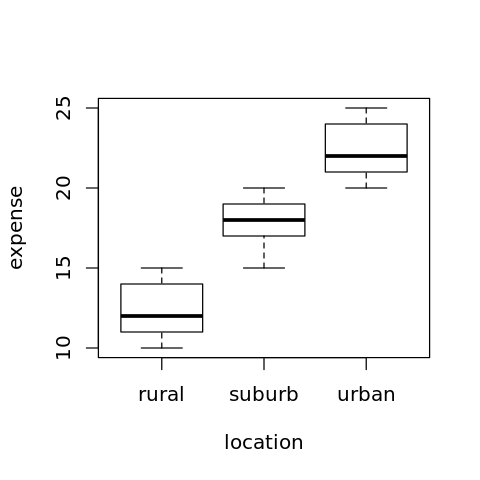
4.5.1.5. Visualizing the differences
[18]:
options(repr.plot.width=5, repr.plot.height=3)
op = par(mar = c(5, 8, 4, 2))
plot(t, cex=0.2, las=1)
par(op)
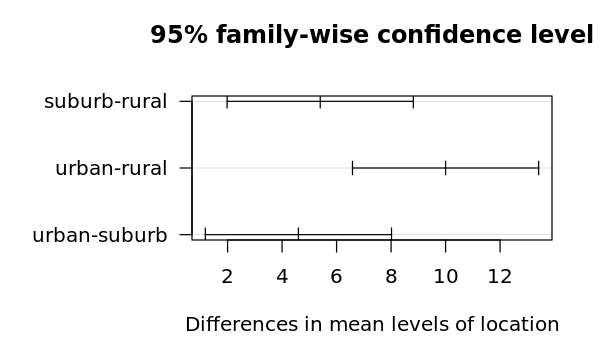
4.5.2. Two-way ANOVA
[19]:
suppressMessages({
library('dplyr')
})
N = 5
a <- 5 + 20 * rnorm(N, mean=20, sd=1) + 4 * rnorm(N, mean=4, sd=1) # urban-high
b <- 5 + 18 * rnorm(N, mean=18, sd=1) + 2 * rnorm(N, mean=2, sd=1) # urban-low
c <- 5 + 10 * rnorm(N, mean=10, sd=1) + 4 * rnorm(N, mean=4, sd=1) # suburban-high
d <- 5 + 8 * rnorm(N, mean=8, sd=1) + 2 * rnorm(N, mean=2, sd=1) # suburban-low
e <- 5 + 5 * rnorm(N, mean=5, sd=1) + 4 * rnorm(N, mean=4, sd=1) # rural-high
f <- 5 + 3 * rnorm(N, mean=3, sd=1) + 2 * rnorm(N, mean=2, sd=1) # rural-low
df <- data.frame(
expense=c(a, b, c, d, e, f),
location=c(rep('urban', 2*N), rep('suburban', 2*N), rep('rural', 2*N)),
income=c(rep('high', N), rep('low', N), rep('high', N), rep('low', N), rep('high', N), rep('low', N)),
stringsAsFactors=TRUE
)
[20]:
r <- aov(expense ~ location * income, data=df)
print(r)
print('-- summary below --')
print(summary(r))
Call:
aov(formula = expense ~ location * income, data = df)
Terms:
location income location:income Residuals
Sum of Squares 687822.6 24346.4 4833.1 7098.1
Deg. of Freedom 2 1 2 24
Residual standard error: 17.19753
Estimated effects may be unbalanced
[1] "-- summary below --"
Df Sum Sq Mean Sq F value Pr(>F)
location 2 687823 343911 1162.825 < 2e-16 ***
income 1 24346 24346 82.319 3.17e-09 ***
location:income 2 4833 2417 8.171 0.00197 **
Residuals 24 7098 296
---
Signif. codes: 0 ‘***’ 0.001 ‘**’ 0.01 ‘*’ 0.05 ‘.’ 0.1 ‘ ’ 1
4.5.2.1. Two-Way ANOVA post-hoc
[21]:
t <- TukeyHSD(r)
print(t)
Tukey multiple comparisons of means
95% family-wise confidence level
Fit: aov(formula = expense ~ location * income, data = df)
$location
diff lwr upr p adj
suburban-rural 60.83863 41.63207 80.04519 1e-07
urban-rural 347.27478 328.06822 366.48134 0e+00
urban-suburban 286.43615 267.22959 305.64271 0e+00
$income
diff lwr upr p adj
low-high -56.97529 -69.93585 -44.01473 0
$`location:income`
diff lwr upr p adj
suburban:high-rural:high 69.64827 36.01835 103.278196 0.0000173
urban:high-rural:high 377.50133 343.87140 411.131254 0.0000000
rural:low-rural:high -30.95116 -64.58109 2.678762 0.0837968
suburban:low-rural:high 21.07783 -12.55210 54.707751 0.4049037
urban:low-rural:high 286.09707 252.46714 319.726994 0.0000000
urban:high-suburban:high 307.85306 274.22313 341.482983 0.0000000
rural:low-suburban:high -100.59943 -134.22936 -66.969509 0.0000000
suburban:low-suburban:high -48.57045 -82.20037 -14.940521 0.0019940
urban:low-suburban:high 216.44880 182.81887 250.078723 0.0000000
rural:low-urban:high -408.45249 -442.08242 -374.822567 0.0000000
suburban:low-urban:high -356.42350 -390.05343 -322.793579 0.0000000
urban:low-urban:high -91.40426 -125.03418 -57.774335 0.0000002
suburban:low-rural:low 52.02899 18.39906 85.658913 0.0009103
urban:low-rural:low 317.04823 283.41831 350.678157 0.0000000
urban:low-suburban:low 265.01924 231.38932 298.649168 0.0000000
4.5.2.2. Two-Way ANOVA effects
[22]:
e <- model.tables(r, type='effects')
print(e)
Tables of effects
location
location
rural suburban urban
-136.04 -75.20 211.24
income
income
high low
28.488 -28.488
location:income
income
location high low
rural -13.012 13.012
suburban -4.202 4.202
urban 17.214 -17.214
4.5.2.3. Two-Way ANOVA means
[23]:
m <- model.tables(r, type='means')
print(m)
Tables of means
Grand mean
168.0042
location
location
rural suburban urban
32.0 92.8 379.2
income
income
high low
196.49 139.52
location:income
income
location high low
rural 47.4 16.5
suburban 117.1 68.5
urban 424.9 333.5
4.5.2.4. Two-Way ANOVA means visualization
[24]:
options(repr.plot.width=5, repr.plot.height=5)
op = par(mar = c(8, 4, 4, 2))
boxplot(expense ~ location * income, data = df, cex.axis = 0.9, las=2, xlab='')
par(op)
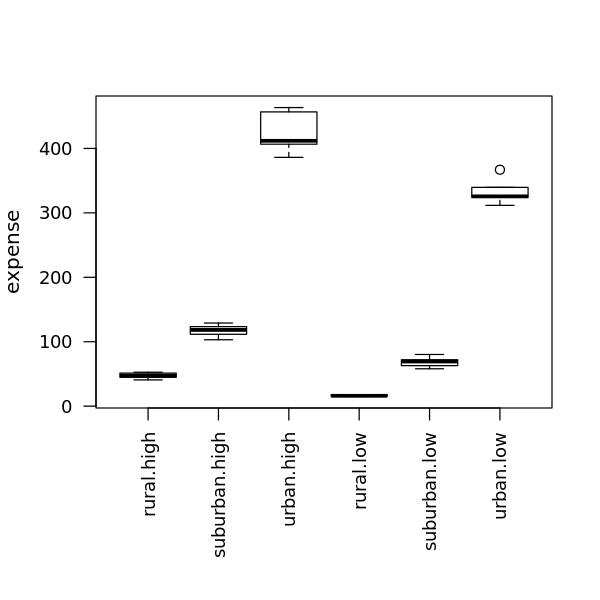
4.5.2.5. Two-Way ANOVA differences visualization
[25]:
options(repr.plot.width=5, repr.plot.height=3)
op = par(mar = c(5, 14, 4, 2))
plot(t, cex=0.2, las=1)
par(op)
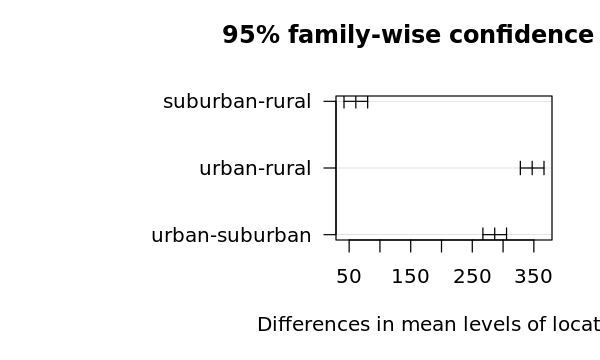
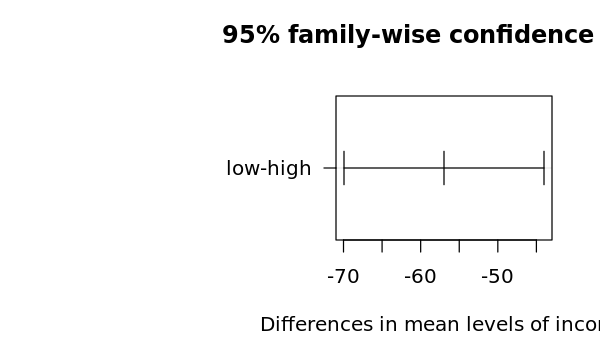
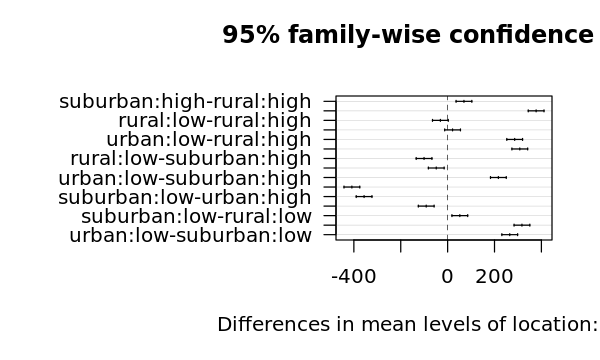
4.5.2.6. Two-Way ANOVA interaction plot
[26]:
options(repr.plot.width=5, repr.plot.height=5)
attach(df)
interaction.plot(location, income, expense)
detach(df)
